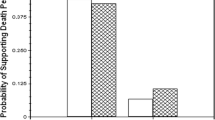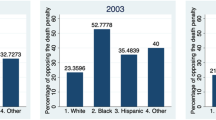Abstract
Polls exploring attitudes toward the death penalty typically impose a simple, dichotomous response structure: respondents are asked whether or not they support or oppose capital punishment. This polling strategy deprives respondents of expressing an indication of the strength of their opinions. When asked whether they support (or oppose) the death penalty “strongly” or “not strongly,” significant proportions of respondents select the latter category. This suggests that many proponents and opponents of the death penalty have weakly-held views regarding the issue. These respondents are of great interest because they are the individuals most likely to change their views. This article analyzes responses to two national surveys in order to explore the variables that differentiate respondents with strongly-held and weakly-held views. A theoretical account is offered to explain why some people have weakly-held views on this critical social issue.
Similar content being viewed by others
References
Alvarez, M. R., & Brehm, J. (1995). American ambivalence towards abortion policy: Development of a heteroskedastic probit model of competing values.American Journal of Political Science, 39, 1055–1083.
Alvarez, M. R., & Brehm, J. (1998). Speaking in two voices: American equivocation about the Internal Revenue Service.American Journal of Political Science, 42, 418–453.
Alvarez, M. R., & Brehm, J. (2002).Hard choices, easy answers: Values, information, and American public opinion. Oxford, England: Oxford University Press.
Applegate, B. K., Cullen, F. T., Fisher, B. S., & Van der Ven, T. (2000). Forgiveness and fundamentalism: Reconsidering the relationship between correctional attitudes and religion.Criminology, 38, 719–754.
Blumstein, A., & Wallman, J. (Eds.). (2000).The crime drop in America. New York: Cambridge University Press.
Bobo, L., & Johnson, D. (2004). A taste for punishment: Black and White Americans’ views on the death penalty and the war on drugs.Du Bois Review, 1, 151–180.
Bobo, L., & Kluegel, J. R. (1993). Opposition to race-targeting: Self-interest, stratification ideology, or racial attitudes.American Sociological Review, 58, 443–464.
Bohm, R. M. (1992). Toward an understanding of death penalty opinion change in the United States: The pivotal years, 1996 and 1997.Humanity and Society, 16, 524–542.
Bohm, R. M., Clark, L. J., & Aveni, A. F. (1991). Knowledge and death penalty opinion: A test of the Marshall hypothesis.Journal of Research in Crime and Delinquency, 28, 360–387.
Bohm, R. M., & Vogel, B. L. (2004). More than ten years after: The long-term stability of informed death penalty opinions.Journal of Criminal Justice, 32, 307–327.
Bohm, R. M., & Vogel, R. E. (1994). A comparison of factors associated with uninformed and informed death penalty opinions.Journal of Criminal Justice, 22, 125–143.
Bohm, R. M., Vogel, R. E., & Maisto, A. A. (1993). Knowledge and death penalty opinion: A panel study.Journal of Criminal Justice, 21, 29–45.
Borg, M. J. (1997). The southern subculture of punitiveness?: Regional variation in support for capital punishment.Journal of Research in Crime and Delinquency, 34, 25–46.
Bowers, W. J., Van Diver, M., & Dugan, P. H. (1997). A new look at public opinion on capital punishment: What citizens and legislators prefer. In S. A. Scheingold (Ed.),Politics, crime control, and culture (pp. 243–316). Brookfield, MA: Dartmouth.
Brewer, P. R. (2003). The shifting foundations of public opinion about gay rights.Journal of Politics, 65, 1208–1220.
Britt, C. L. (1998). Race, religion, and support for the death penalty: A research note.Justice Quarterly, 15, 175–191.
Center for Disease Control. (2004).Abortion facts. [On-line]. Available: www.cdc.gov/ search.do?action=search&queryText=abortion.
Cullen, F. T., Fisher, B. S., & Applegate, B. K. (2000). Public opinion about punishment and corrections. In M. Tonry (Ed.),Crime and justice: A review of research, Vol. 27 (pp. 1–79). Chicago: University of Chicago Press.
Death Penalty Information Center. (2004).Innocence and the death penalty. [On-line]. Available: www.deathpenaltyinfo.org/article.php?did=412&scid=6.
Durham, A. M., Elrod, H. P., & Kinkade, P. T. (1996). Public support for the death penalty: Beyond Gallup.Justice Quarterly, 13, 705–730.
Ellsworth, P., & Ross, L. (1983). Public opinion and capital punishment: Close examination of the views of abolitionists and retentionists.Crime and Delinquency, 29, 116–169.
Equal Justice USA. (2004).National tally of groups against the death penalty. [On-line]. Available: www.quixote.org/ej/ej_tally_of_moratorium_signers_by_st.html.
Fan, D. P., Keltner, K. A., & Wyatt, R. O. (2002). A matter of guilt or innocence: How news reports affect support for the death penalty.International Journal of Public Opinion Research, 14, 439–451.
Feldman, S. (1988). Structure and consistency in public opinion: The role of core beliefs and values.American Journal of Political Science, 32, 416–440.
Feldman, S., & Steenbergen, M. R. (2001). The humanitarian foundation of public support for social welfare.American Journal of Political Science, 45, 658–677.
Grasmick, H. G., & McGill, A. L. (1994). Religion, attributional style, and punitiveness toward juvenile offenders.Criminology, 32, 2i-A6.
Hagan, J., & Albonetti, C. (1982). Race, class, and the perception of criminal injustice in America.American Journal of Sociology, 88, 329–355.
Halim, S., & Stiles, B. L. (2001). Differential support for police use of force, the death penalty, and perceived harshness of the courts.Criminal Justice and Behavior, 28, 3–23.
Harry, J. L. (2000). Death penalty disquiet stirs nation.Corrections Today, 62, 122.
Hetherington, M. J., & Globetti, S. (2002). Political trust and racial policy preferences.American Journal of Political Science, 46, 253–275.
Hood, R. (2002).The death penalty. A worldwide perspective (3rd ed.). Oxford, England: Oxford University Press.
Jones, P. (1994). It’s not what you ask, it’s the way that you ask it: Question form and public opinion on the death penalty.The Prison Journal, 73, 32–50.
Kinder, D. R., & Sanders, L. M. (1996).Divided by color. Chicago: University of Chicago Press.
Kinder, D. R., & Winter, N. (2001). Exploring the racial divide: Blacks, Whites and opinion on national policy.American Journal of Political Science, 45, 439–456.
Lambert, E., & Clarke, A. (2001). Individual’s support of the death penalty: A partial test of the Marshall hypothesis among college students.Criminal Justice Policy Review, 12, 215–234.
Lord, C. G., Ross, L., & Lepper, M. R. (1979). Biased assimilation and attitude polarization: The effects of prior theories on subsequently considered evidence.Journal of Personality and Social Psychology, 37, 2098–2109.
Mallicoat, S. L., & Radelet, M. (2004). From the field: The growing significance of public opinion for death penalty jurisprudence.Journal of Crime and Justice, 27, 119–130.
Moon, M. M., Wright, J. P., Cullen, F. T., & Pealer, J. A. (2000). Putting kids to death: Specifying public support for juvenile capital punishment.Justice Quarterly, 17, 663–684.
Nice, D. C. (1992). The states and the death penalty.Western Political Quarterly, 45, 1037–1048.
Niven, D. (2002). Bolstering an illusory majority: The effects of the media’s portrayal of death penalty support.Social Science Quarterly, 83, 671–689.
Payne, B. K., Gainey, R. R., Triplett, R. A., & Danner, M. J. E. (2004). What drives punitive beliefs? Demographic characteristics and justifications for sentencing.Journal of Criminal Justice, 32, 195–206.
Pew Research Center (2004).Religion and politics: Contention and consensus. [On-line]. Available: http://people-press.org/reports/display.php3/PageID=725.
Rankin, J. H. (1979). Changing attitudes toward capital punishment.Social Forces, 58, 194–211.
Roberts, J. V., & Stalans, L. J. (1997).Public opinion, crime, and criminal justice. Boulder, CO: Westview Press.
Ryan, G. H. (2000).Press release, Office of Governor George H. Ryan. [On-line]. Available: www.state.il.us/gov/press/00/Jan/morat.htm.
Sampson, R., & Bartusch, D. J. (1998). Legal cynicism and (subcultural?) tolerance of deviance: The neighborhood context of racial differences.Law and Society Review, 32, 777–804.
Sandys, M., & McGarrell, E. F. (1997). Beyond the Bible belt: The influence (or lack thereof) of religion on attitudes toward the death penalty.Journal of Crime and Justice, 20, 179–190.
Sarat, A. (2001).When the state kills. Princeton, NJ: Princeton University Press.
Sears, D. O., & Henry, P. J. (2003). The origins of symbolic racism.Journal of Personality and Social Psychology, 85, 259–275.
Sears, D. O., Van Laar, C., Carrillo, M., & Kosterman, R. (1997). Is it really racism?: The origins of White Americans’ opposition to race-targeted policies.Public Opinion Quarterly, 61, 16–53.
Soss, J., Langbein, L., & Metelko, A. R. (2003). Why do White Americans support the death penalty?Journal of Politics, 65, 397–421.
Sourcebook of Criminal Justice Statistics. (2004a).Attitudes toward the death penalty. Table 2.49. [On-line]. Available: www.albany.edu/sourcebook/pdf/t246.pdf.
Sourcebook of Criminal Justice Statistics. (2004b).Attitudes toward the death penalty for persons convicted of murder. Table 2.49. [On-line]. Available: www.albany.edu/source book/pdf/t249.pdf.
Sprott, J. B. (1999). Are members of the public tough on crime? The dimensions of public “punitiveness.”Journal of Criminal Justice, 27, 467–474.
Stack, S. (2000). Support for the death penalty: A gender-specific model.Sex Roles, 43, 163–179.
Stack, S. (2003). Authoritarianism and support for the death penalty: A multivariate analysis.Sociological Focus, 36, 333–352.
Tonry, M. (1999). Why are U.S. incarceration rates so high?Crime and Delinquency, 45, 419–437.
Tyler, T. R., & Boeckmann, R. J. (1997). Three strikes and you are out, but why?: The psychology of public support for punishing rule breakers.Law and Society Review, 31, 237–265.
Unnever, J. D., & Cullen, F. T. (2004).Reassessing the racial divide in support for capital punishment: The continuing significance of race. Unpublished manuscript.
Unnever, J. D., & Cullen, F. T. (2005). Executing the innocent and support for capital punishment: Implications for public policy.Criminology and Public Policy, forthcoming.
Unnever, J. D., Cullen, F. T., & Applegate, B. (2004).Turning the other cheek: Moving beyond fundamentalism in explaining punitive ideology. Unpublished manuscript.
Vogel, B. L., & Vogel, R. E. (2003). The age of death: Appraising public opinion of juvenile capital punishment.Journal of Criminal Justice, 31, 169–183.
Wright, H. O., Jr., Bohm, R. M., & Jamieson, K. M. (1995). A comparison of uninformed and informed death penalty opinions: A replication and expansion.American Journal of Criminal Justice, 20, 57–87.
Young, R. L. (1992). Religious orientation, race and support for the death penalty.Journal for the Scientific Study of Religion, 31, 76–87.
Young, R. L. (2004). Guilty until proven innocent: Conviction orientation, racial attitudes, and support for capital punishment.Deviant Behavior, 25, 151–167.
Zimring, F. (2003).The contradictions of American capital punishment. Oxford, England: Oxford University Press.
Author information
Authors and Affiliations
Corresponding author
Rights and permissions
About this article
Cite this article
Unnever, J.D., Cullen, F.T. & Roberts, J.V. Not everyone strongly supports the death penalty: Assessing weakly-held attitudes about capital punishment. Am J Crim Just 29, 187–216 (2005). https://doi.org/10.1007/BF02885735
Issue Date:
DOI: https://doi.org/10.1007/BF02885735




